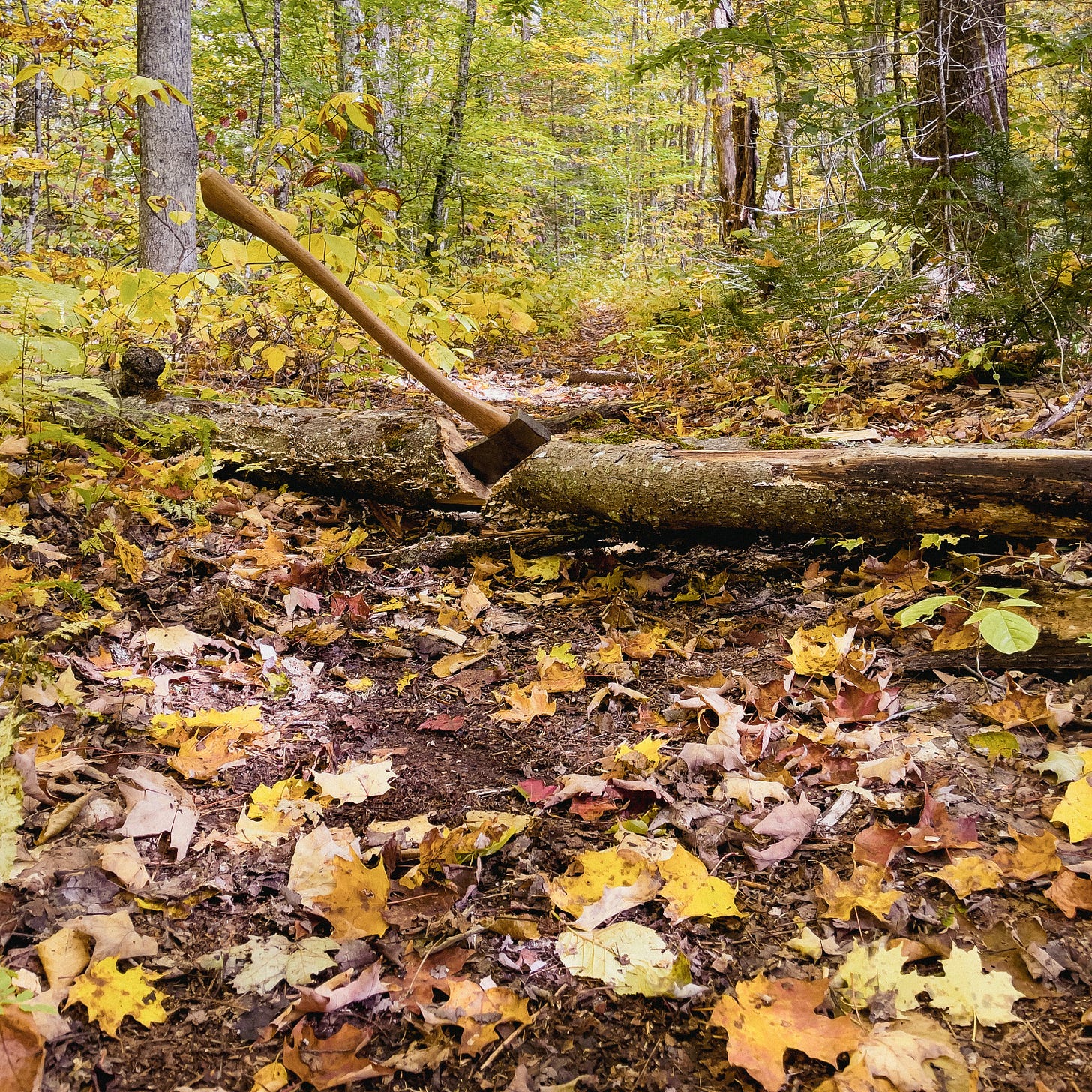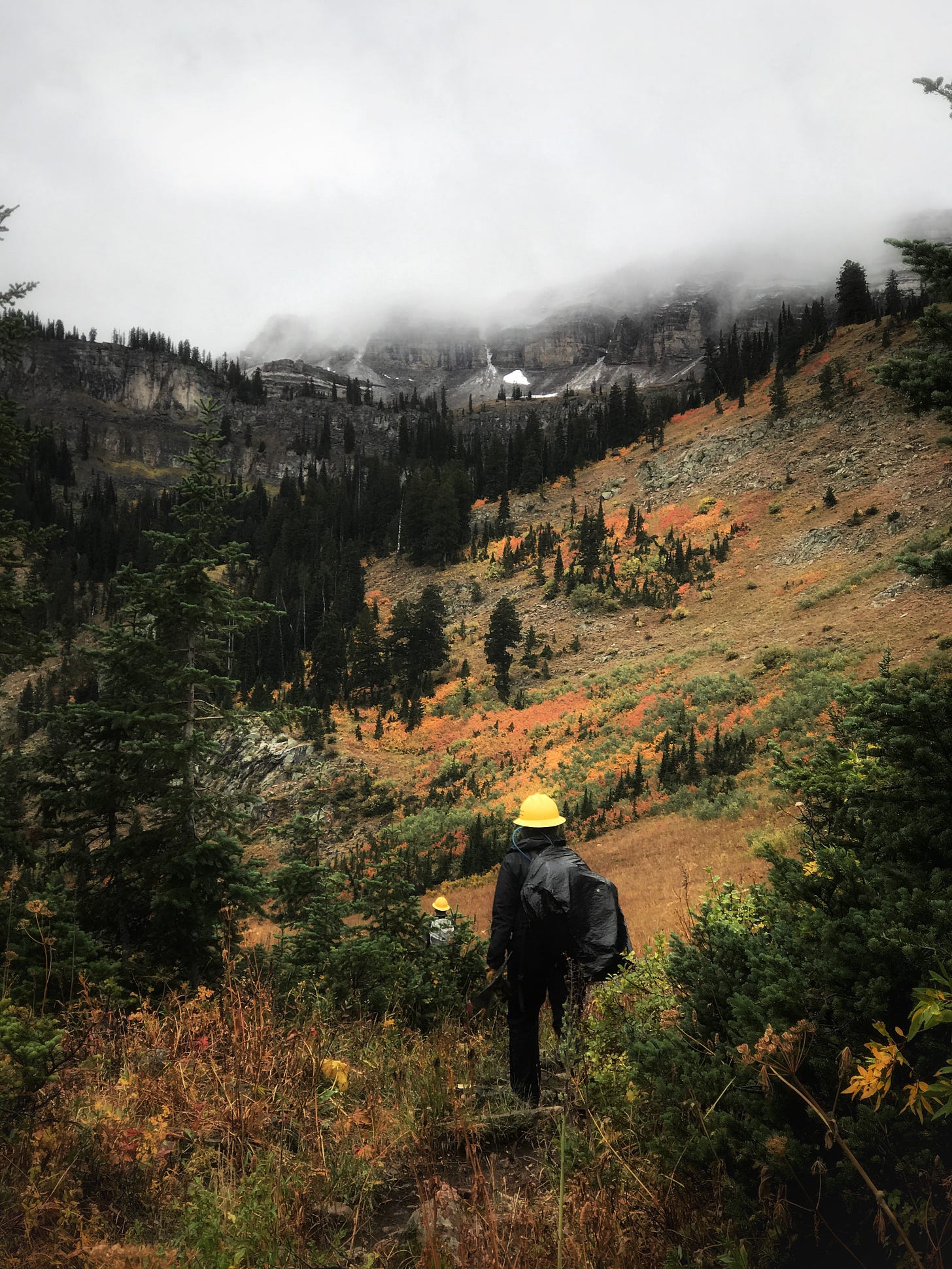By the time thru-hikers on the Appalachian Trail reach the White Mountains, usually in June or July, memories of the previous winter have long since melted and trickled into the Great Gulf. Even the nights are hot now, the diapensia and alpine azaleas have shriveled to their ruby stems, and all around you, below you, the sea of green forest stretches almost completely unbroken to the blue haze in the distance. Your season, like the heavy, green leaves, is neither coming nor going. It’s simply here. Like your season, you think of this forest as a green thing, a thing with leaves, even though the green lasts hardly a third of the year in New Hampshire, and the leaves only half.
One day in August, on the side of the trail, you spot a leaf that isn’t green. A new color jumps out at you: yellow. It’s on a maple tree, or a mountain ash, or the fringe of a hobblebush. It’s early. Trees and other deciduous plants may change colors early when stressed, as the green chlorophyll breaks down faster than the plant can produce it. This plant could be sick, it could be unfit or otherwise compromised, or it could simply be the forest’s faint cry after several years of drought (in New England! In New England!). Whatever’s caused it, it’s ticking like a clock. It jolts some sleeping part of you awake: the season is ending. Not right now but eventually. Somehow half the season has passed, though you must do some counting to prove it. But you’ve seen that leaf before, and you know what it means. More leaves on that plant will turn. More trees will follow—if they haven’t begun already.
Thus the seasonal federal land-management-agency worker is hitched to everything else in the universe. Like the leaf, like the bears and the blueberries, like the monarchs and the wildflowers before them—probably in some unknown way because of those flowers—you’ve been set in motion, triggered by an ecological cue. Oh my god, you realize. You need to find another job.
Not since you were a kid on summer break have you felt the approach of a season so viscerally, practically in your bones. Indeed it’s somewhat incredible that a society as modern as this one claims to be, and as uncoupled from natural cycles, still manages to teach this lesson to its schoolchildren. Of course, it’s eventually forgotten as we matriculate into social roles whose nine-to-five schedule persists all year long, through the year’s longest days and nights, and the personal relevance of the changing seasons contracts into the realm of holidays and hobbies. Perhaps this is why seasonal work today has alternately quaint, childlike, or unsettled connotations—migrant work, summer jobs. What you do when you’re young, retired, or adrift.
But like school or farm work, seasonal work in the land management agencies is a serious matter. Scientists, wilderness rangers, wildland firefighters, and many other highly skilled, educated professionals—and you feral trail workers too—make up its ranks. And though many folks in the agencies do pick up their seasonal jobs between other, higher priorities, like college kids making a quick summer killing on a fire line, most of them are at least open to the prospect of a longer-term career in their field. Yet all full-time permanent jobs in the federal land agencies have strict requirements for duration of service and years of experience—particularly for the specialized fieldwork that only really exists in or around the agencies themselves. How do you obtain this experience? By working a season, and another, and another.
This not only seasonal but, over many years, cyclical professional reality puts something of an odyssey in your path to a long land-management career. Find your way through as many seasons of agency work as needed, pick up as many off-season gigs to survive as you can, until the day comes when you qualify for a year-round position. It’s the defining phase of the seasonal-worker life cycle. And so as summer turns its corner, and the approaching fall tugs more and more threads in the forest tapestry—as the nights go from stifling to cool, as the last blueberries disappear from the bushes—you feel at least a distant nagging from your instinct to crack open that resume folder, rifle through job boards, and get the damned thing over with.
Naturally, for the rest of August, you ignore it. You still have plenty of time. You welcome the quick passage of summer’s last sweltering days, and on weekends you cross your curiously divided range to your full-time home in Vermont, where the season seems a little further behind. All summer you’ve been living in your tent and in your car, with a three-hour “commute” on Sundays and Thursdays. Somehow this relative proximity happens to be one of the more settled, rooted living arrangements you or your other seasonal comrades have had over the years—it’s in the top five that you know of, anyway.
It still feels like July in the Champlain Valley when September catches you by surprise. Just a month left. One evening at home you take a walk down to the lake. The lake and sky frame the royal blue Adirondacks in beams of golden light, but the thing that entrances you is not what you see over the water, but what you hear. Geese. Out over the middle of the lake is what looks like an avian highway running from South Hero to Ticonderoga. So many geese are heading south together that their V’s are forming alphabets. Do we need to spell it out for you?
Back at work, old questions make the rounds. “Know what you’re doing in the off-season?” Nobody does yet. For an occupation as long in the tooth, as unchanged by time and sheer dumb American progress, as seasonal Forest Service employee, you’d think there’d be more of a roadmap. Once, years ago, you assumed others in the industry might have good advice for reliable, well-paying, transferrable winter seasonal jobs. How else could seasonals hope to make it through the years of job changes, cross-country moves, and inevitable gaps in job history and direct deposits? But the answers then were the same ones you’re getting now: “no clue.” When even the skiers you’ve worked with seem ambivalent about the coming winter, you know you’re in a tough spot. Maybe they’ll go back to the ski resort, they say. Maybe they’ll hop on a fire crew somewhere. Maybe they’ll go back to AmeriCorps for a fall or winter term down south. Maybe they’ll get called back for that year-round trails job they just applied to—at a nonprofit, though, not an agency. Maybe they’ll take it.
The resolution of such personal-professional uncertainties would be a defining event in an average person’s decade, and the seasonal worker faces them twice a year. After a few seasons, it doesn’t daunt you. What’s the worst that could happen—unemployment? “I’m honestly thinking of doing nothing,” a friend says without irony. Another contemplates a repeat winter on BLM land in Arizona with their van, their pellet gun, and some cans. (Privileged, perhaps—but among trail workers, the result of extreme thrift and asceticism as often as lucky upbringing.)
But most do eventually find work, and often impressive work at that. Carpenters, arborists, commercial and fine-art welders, ranchers, freelancers, artists and artisans—the list of off-season trail worker professions goes on. Achieving real prosperity through the cycles of seasonal work demands not specialization, as most jobs in our society do, nor jack-of-all-trades generalization, but the more difficult task of cultivating several unrelated skillsets at a high level. If there’s any foolproof blueprint for a coherent seasonal trails career, it seems to require being an elite winter-sports athlete—a ski-mountaineering guide, an avalanche forecaster, a snow ranger patrolling ice and backcountry routes—letting your seasons fuse together like yin and yang. Or you can go fish for crab in Alaska. Simple, right?
While you contemplate your lack of high-level skills, in trails or elsewhere, your days shorten, and the forest transforms. Pockets of gold, crimson, and amber foliage spread out at just shy of a perceptible speed, and one morning your drive down Route 16 to the ranger station has changed from routine to sublime all but overnight. The fall colors “peak” for two straight weeks. Now comes an ache unrelated to job searches and resumes. You don’t want to go. Not yet. Before you know it, it’s your last hitch, your last patrol. You’re fit, your food and gear are dialed, your axe swings true. You’ve spent the season growing something like antlers. Soon you’ll shed all of it, become a silent shadow subsisting on memories of green, but this is who you are.
Another seasonal migration is about to begin. As job offers arrive, seasonal staff fall away like leaves on a half-bare tree. Autumn, like seasonal work, demands both reflection and frantic preparation in a way that can seem at odds—there’s just barely enough time in one season for both. At your most reflective, you think it gets at a certain hazy truth. Seasonality is as old as humanity itself; many cultures throughout history have changed their social and even political arrangements with the seasons, embracing free egalitarianism for part of the year, tolerating hierarchies in another. It’s likely, according to one convincing theory, that this “grand seasonal theater” of movement, migration, and change led to human political self-consciousness to a degree scarcely imaginable to modern Americans—the understanding that things need not be how they are right now, and that people can change them. You spend your last day sharpening your axe. What are we but the work we do? You don’t mean your job—if seasonal work has taught you anything, it’s the difference between the two.








Very Impressive article. It’s too bad that the Forest service does not understand what it asks if it’s seasonal workers.
Very well written.
I really enjoy this newsletter — both as a hiker who is grateful for the work of trail crews, and as a (new) seasonal farm laborer in VT. Looking forward to more beautiful posts!